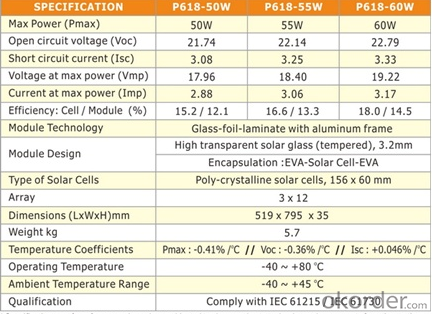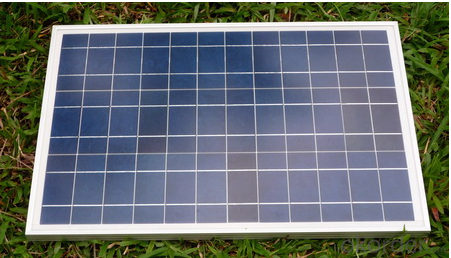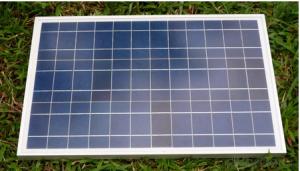50W mono Solar Photovoltaic Panel high efficiency with high output for sale
- Loading Port:
- Shanghai
- Payment Terms:
- TT OR LC
- Min Order Qty:
- 1000 watt
- Supply Capability:
- 50000 watt/month
OKorder Service Pledge
OKorder Financial Service
You Might Also Like
Introduction
50W Solar Photovoltaic Panel CE TUV UL CERTIFICATE,this panel is only design for HOME with higer output version with stable power and we gurantee you for 20years.
suggestied application
home lighting business lighting,
Garden lighting, pavement lighting
Farmer household lighting
Decorative water pump
Traffic signal lighting
industry area
business area
Solar Power Plant, Solar House
Product features
1. Most competitive rates;
2. Fast delivery time;
3. High quality;
4. Strong package;
5. OEM available; solar panel
6.junction box, which could prevent the effects dark spots of local damage to cells.
7.Resistance to fluctuations of temperature, humidity and strong wind
8.Manufactured under IEC61215 Solar Photovoltaic Panel requirements
packing
Individual carton box for solar panel
2 solar modules in a carton
A carton board separates two solar panel
For LCL goods, we use bulk carton box or wooden boxes
Parameters


- Q:Can solar panels be integrated into building materials?
- Yes, solar panels can be integrated into building materials. This integration is known as Building Integrated Photovoltaics (BIPV), where solar panels are designed to blend seamlessly into the architecture of a building, such as being incorporated into windows, roofs, or facades. BIPV offers a dual purpose of generating renewable energy while serving as a functional building material.
- Q:Can solar panels be installed on factories or industrial buildings?
- Yes, solar panels can be installed on factories or industrial buildings. In fact, many industrial companies are increasingly installing solar panels on their roofs or open spaces to generate clean and renewable energy. This helps to reduce their dependence on fossil fuels, lower their energy costs, and contribute to a more sustainable and environmentally-friendly operation.
- Q:About how much would it cost to purchase and install solar panels for the average American house so that the house can be off the power grid and use the same amount of electricity as it normally does?
- We are installing a 3.3 kWh system on a 2 story house. Really three story if you add in the basement. It will provide about 3/4 of the electric power they use per year. The cost of the complete system installed is in the $26,000 range. A 4.5 kWh system would wipe out their bill and would cost in the $34,000 range installed. But it had too many solar modules to fit on the roof. Now if you are wanting to go off grid in the average American home you would spend about $60,000 easy. Most American family's are very very waste full. Very few even have CFL lighting and leave every light in the house on. I have even known of some that will use a 60 watt night light when it is so easy to put in a CFL or a 4 watt night light. With 4 TV sets running in most homes at the same time a 200 watt stereo system for background noise.. Well we Americans have a long ways to go yet.
- Q:Can solar panels be installed on historical or protected buildings?
- Yes, solar panels can be installed on historical or protected buildings. However, the installation process may require careful planning and consideration to preserve the building's historical integrity. This typically involves working closely with preservation experts, architects, and local authorities to find suitable installation methods that minimize visual impact and potential damage to the structure.
- Q:I'm just geting into electonics and stuff. So I am trying to make a simple USB charger. I'm looking for at least 4 volts output. What I've got is two solar panels (detached) a 4 AA battery holder, and a circuit board with an led on it (took the solar panels out of old lawn lights. I need more charge out of my panels (I think) so I tried attaching them. I soldered the positive wire from one to the positive connection on the other and negative wire to negative connection. After doing so and checking the multimeter, it says I have no output at all. How do you connect them?
- Huh? you should have got something, in full sun, you should have gotten 3 or 4 volts, but milliamps in current. By connecting them pos. to pos., neg to neg,(paralell) it increases the current output. If you connect pos, on one, to neg. on the other, and measure between the remaining pos, and neg. you should have twice the voltage (series). You need 4 volts, but 4 AA's in series is 6 volts. If your going to use the panels to charge the batteries, you'll need a diode in series to prevent discharge during dark conditions, which the LED will work for.
- Q:How much would it cost to make an average size house be able to depend on solar panels for all of its power?How many solar panels would you need and wear would you put them? Would the roof be large enough to support the panels needed?Do solar panels work well in higher latitudes like northern USA or southern Canada? Can you power your house for the whole year if you live in these environments? What kind of maintenance do solar panels require?
- There are several web sites you can search for and they will provide the answer on how big of a PV Solar Array you would need for your house. Several things need to be known, such as square footage of the home, how well the home is insulated, etc. The panels come in all sizes and wattage's depending upon application, so yes they should all fit on the roof. If you have a small roof get PV panels with higher wattage's. Yes, they will work in the northern latitudes but not as efficiently as near the equator. You might need more PV panels to make up the loss in power from the sun hitting at a lower angle. Generally, all you will need to do is periodically clean the glass covering of the PV Panels to get maximum sun light on the PV cells. In my region, near the 45 th parallel, a 600 square foot home with six inch insulated walls and R40 attic insulation can purchase a PV panel system for around $40,000. That includes the equipment to tie it into the power grid and the meter to measure how much you supply the grid during the day and how much you draw from the grid at night when the sun isn't shining. There are tax credits for retrofitting an existing home, but mostly it is new homes being built that are having the PV panel systems installed so the cost is added to the mortgage and the return on the investment is paid off over the life of the System (about 5 to 20 yrs.)
- Q:Can solar panels be used to power a train?
- Yes, solar panels can be used to power a train. Solar panels generate electricity by converting sunlight into energy, which can be used to power various systems, including trains. However, the feasibility and efficiency of using solar panels to power a train will depend on several factors such as the size of the train, the available surface area for solar panel installation, the train's energy requirements, and the geographical location's solar potential.
- Q:Can solar panels be damaged by hail or other flying debris?
- Yes, solar panels can be damaged by hail or other flying debris. Hailstones, in particular, can cause cracks, dents, or even punctures on the surface of solar panels, reducing their efficiency or functionality. To mitigate the risk of damage, many solar panels are designed to withstand certain levels of impact and are typically tested for durability. Additionally, some solar panel installations utilize protective measures, such as tempered glass or anti-hail nets, to minimize potential damage caused by hail or flying debris.
- Q:i attached a usb charger to my solar panel(it has an output of about .2 volts) but i read on my multimeter its only using about 8 volts however on the conventional wall charger that i use to charge it has an output of about 5. volts.... i believe that my mp3 player is not charging it does not display the charging icon when it is on or off ....is this becuase the output is higher ? do i need to install a volt dropping diode to prevent it from putting to much energy at once? (my mp3 charges fine on the wall charger but does not seem to respond to the solar panel so it the circuits are fine....)
- You description is not clear as to what is supplying and what is consuming the .2, 8, and 5. volts you mention. I get that your solar panel output is .2 VDC (volts DC), but is that open circuit or under load? Also, is the charger output AC or DC? What's using 8 volts? Circuits don't selectively use a portion of the voltage supplied. They use all or nothing. Is the polarity correct from your solar panel to your MP3 player? If your MP3 player requires DC for charging and you're feeding it the correct polarity, but too high a voltage, an overvoltage protection circuit in your MP3 charging circuit might be blocking the charging current from your solar panel. Go through everything again and if you need to post another question on YA, be specific as to what you're measuring, where, and whether it's the source or load you're measuring.
- Q:How could I find out what the amp output of a solar panel? Specifically, I want to know how many milliamps can the solar panel on a Casio fx-260 put out?
- You need full sunshine from the sun, or a lamp that will give a light spectrum similar to the sun, a volt meter, Milli-amp meter, and a variable resistor of 0 to 000 ohms. The voltmeter test leads go across the solar cell leads. The amp meter leads will be in series with the solar cell. Let's say, positive lead of the solar cell to the the positive lead of the amp meter, the negative lead of the amp meter to one terminal of the variable resistor, and the wiper terminal of the variable resistor to the negative lead of the solar cell. Slowly decrease the value of the resistor until the voltage from the solar cell just begins to drop. Take note of the amp meter reading. This is about the high end range of the solar cell. You might want to begin with a micro-amp meter for the current meter.
1. Manufacturer Overview |
|
|---|---|
| Location | |
| Year Established | |
| Annual Output Value | |
| Main Markets | |
| Company Certifications | |
2. Manufacturer Certificates |
|
|---|---|
| a) Certification Name | |
| Range | |
| Reference | |
| Validity Period | |
3. Manufacturer Capability |
|
|---|---|
| a)Trade Capacity | |
| Nearest Port | |
| Export Percentage | |
| No.of Employees in Trade Department | |
| Language Spoken: | |
| b)Factory Information | |
| Factory Size: | |
| No. of Production Lines | |
| Contract Manufacturing | |
| Product Price Range | |
Send your message to us
50W mono Solar Photovoltaic Panel high efficiency with high output for sale
- Loading Port:
- Shanghai
- Payment Terms:
- TT OR LC
- Min Order Qty:
- 1000 watt
- Supply Capability:
- 50000 watt/month
OKorder Service Pledge
OKorder Financial Service
Similar products
New products
Hot products
Related keywords





























